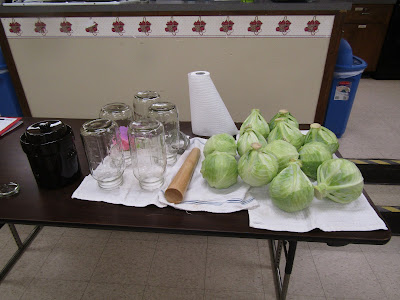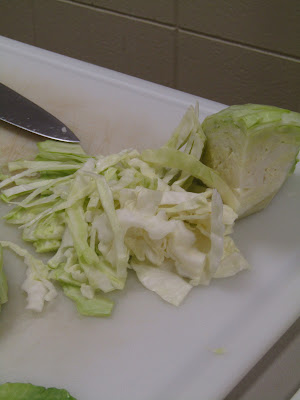One of the goals for our homestead
is to provide ourselves with plenty of home-grown,
home-preserved food.
Our Extension Center recently offered
a class on fermentation,
so I signed up.
The featured recipe was sauerkraut.
It was surprising to find out
that sauerkraut's origins are in China, not Germany.
Kraut is one of those foods that is not remembered fondly
from our childhoods.
And most likely,
if your only experience is eating storebought,
you are really missing out.
Sauerkraut is fermented, so it adds
much needed beneficial bacteria to your gut,
and results in a healthier you.
I'd urge you to give this a go
and see if it doesn't rock your world!
is to provide ourselves with plenty of home-grown,
home-preserved food.
Our Extension Center recently offered
a class on fermentation,
so I signed up.
The featured recipe was sauerkraut.
It was surprising to find out
that sauerkraut's origins are in China, not Germany.
Kraut is one of those foods that is not remembered fondly
from our childhoods.
And most likely,
if your only experience is eating storebought,
you are really missing out.
Sauerkraut is fermented, so it adds
much needed beneficial bacteria to your gut,
and results in a healthier you.
I'd urge you to give this a go
and see if it doesn't rock your world!
Our instructor, Zach Troutman,
is the Family and Consumer Sciences agent
here in Lincoln County.
He provided us with all the tools we needed to take part.
 |
| freshly washed cabbage |
a Super Food!
After washing our hands,
the outer leaves of the cabbage were discarded.
It was then quartered,
and laid it on its side to remove the core.
We then began cutting the cabbage into shreds with a knife.
A box grater, food processor, or mandolin could also be used.
The shreds should be between 1/4"-1/2" wide.
The finer the shred, the easier the kraut will be to process.
We would need 5 pounds of cabbage with 3 Tablespoons of pickling salt per jar.
These large bins were helpful,
in order to be able to work on pounding and massaging the cabbage.
This would be a great job for kids to do,
as they always seem to enjoy hands-on tasks.
As the cabbage is worked, it exudes moisture.
Once there is ample liquid and some foaming visible,
it's time to transfer your batch to a jar.
Zach provided us with gallon-sized Mason jars.
Some of the massaged cabbage was added,
and then this tamping tool was used to discharge even more liquid.
Cabbage continued to be added and tamped
until we filled the jar with our measured amount.
We were instructed to leave at least a 1" space at the top of the jar.
At that point, this giant nipple and a standard canning ring
were added to the jar.
This method removes the need to "burp" the jar during the fermentation.
The excess carbon is released from the hole at the top of the nipple.
Genius, right?
The main concern at this point,
is to ensure that the liquid covers the cabbage.
If not, mold can form,
which is not the end of the world.
It can simply be scraped off the top and the fermentation continues.
The jar needs to sit out of direct sunlight
for 7-14 days.
The kraut can be sampled after 7 days.
The flavor will change as it sits and ferments.
It's basically a matter of personal preference,
so whenever it tastes just right to you,
the jar can be refrigerated.
Kraut can be stored safely for months in the refrigerator.
I can't wait to partake of it.
No doubt, it will be a far cry from the kraut of my younger years.
Another useful skill for us homesteaders to practice.
So grateful to the Extension Center for offering classes
that change lives.
What a gift.











No comments:
Post a Comment
Thanks for taking the time to leave your thoughts!